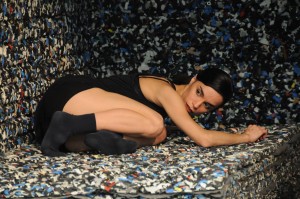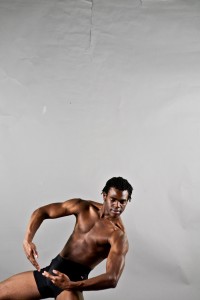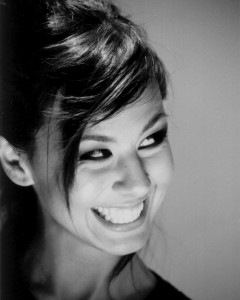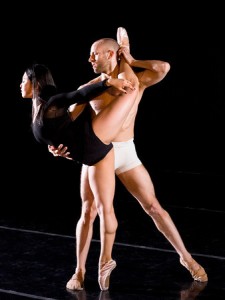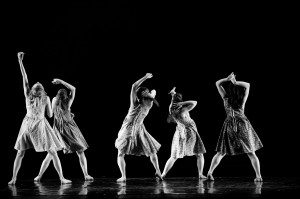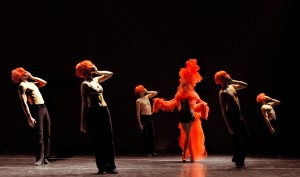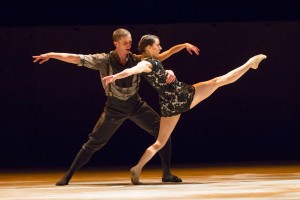A man sits on the floor as three women take turns forcing themselves, crawling, pulling and pushing through the space between his body and arms. Beside him another man sits with his arms overhead as three people crawl over his shoulders and down to the floor like a human waterfall. This is a glimpse of the early stages (as in day two!) of a world premiere being created on Luna Negra Dance Theater (LNDT) by Argentinian choreographer Diana Szeinblum. “Elbow, there, fuerte”, she says from the front of the studio. Szeinblum’s new work Brasilia will be featured with a world premiere by Luna Negra dancer/choreographer Mónica Cervantes, Requiem, and the U.S. premiere of Artistic Director Gustavo Ramírez Sansano’s 2008 work En Busca de (In Search of) at the MCA Stage this weekend as the company presents Lune Nueva, a new initiative exploring unconventional movement styles.
Sansano originally created his work for IT Dansa in Barcelona in honor of one of his teachers that had recently passed away. “I learned a lot from her and really experimented in that piece,” he says from LNDT’s State Street studios. “You know that feeling when you’re excited of what’s coming, but you don’t know what it is, so you’re anxious? She crafted anxious. En Busca de is about the momentum of your life.” Cervantes premiere for six dancers explores the idea pathways set to a classical score of Mozart and Shostakovich. Read a great preview of her piece by Johnny Nevin at 4dancers.org here.
Szeinblum, a dancer/choreographer/actor who started dancing at age six, studied at the Ballet of San Martin Theater in Buenos Aries and at the Folkwang Tanz Schule in Germany under the direction of Pina Bausch. She founded her own company – Diana Szeinblum Dance Company – in 2000. Sansano helped translate our interview two weeks ago at the beginning of her rehearsal process.
RB: What was it like working with Pina?
DS: It was so nice. (laughing) Interesting.
GRS: What was so impressive for her about Pina, is she’d take every detail like it was the first time.
DS: She was incredible. I worked with her and Susana Linka…this marked me.
RB: I read that you call your dances plays. Can you talk about your process?
DS: I always take things from the people an dI say that this, for me, gives the truthfulness to the work, my work. The thing for me is to find in the dance the kind of truth that actors try to find.
RB: Do you stars with a story you want to tell or a concept and give that to the dancers? Do you use a lot of improv?
DS: Improv. Generally, I need to understand where I am. To create first a place or atmosphere. This gives me my limit to start to put all things in this place. For me, this is the most important thing to find.
RB: I know you’ve only been here one day, but for this specific piece, did you know what it was going to be or do you need to work with the dancers first?
GRS: This is a specific situation, because of time, she has to use a concept.
DS: To find it very fast. I think I live in a strange place, so I think I can…I will do something personal.
GRS: The way she works normally with the dancers…everything comes out of them. The story at the end is them, but because it’s such a short time, it’s going to be something personal.
RB: You only have two weeks. How long do you normally work on a piece?
DS: In Argentina, we don’t have money, we don’t have producers, no one will say ‘ok, come on, do it’ This is the only thing that is great for us – that we really have time to do our work. Sometimes it’s four months, sometimes one year.D
RB: How are you changing the way you work to fit the tight time frame?
DS: I have a lot of images. The thing I have to construct how my images go together in this work. The are very nice dancers, very technical dancers. I’m not used the having such technical dancers. I’d really like to try more technical things, but I don’t have a lot of time.
GRS: It’s a different way of working for the company. That’s part of this program (Luna Nueva), to let the dancers have a completely different experience. The were telling me how much fun they had yesterday. Every time you have a new choreographer, it’s a different process. It’s a wonderful experience for us.
RB: How did you find Diana?
GRS: My search. (laughing) My encyclopedia of Latino choreographers.
DS: Where is this encyclopedia?
GRS: I made it!
RB: Do you have an idea of what this piece will be about, or is it too soon to talk about it?
DS: I’m trying to create things that speaks about layers.
Luna Negra Dance Theater presents Luna Nueva at the MCA, 220 E. Chicago Ave., Thursday-Sunday, June 7-1- at 7:30 p.m. Tickets are $28. Call the MCA Box Office at 312.397.4010 or visit www.mcachicago.org.

